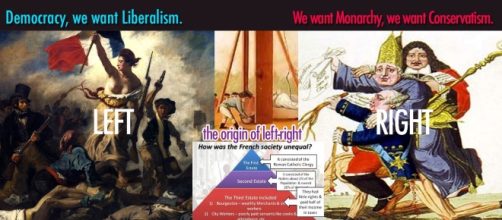Politics is abundant with different ideologies from the traditional socialism, liberalism and conservatism to the extremes of left-wing and right-wing ideologies of communism and fascism. There are also newer ideologies such as neoliberalism, neoconservatism, libertarian plus many more. This often creates issues for those who aren’t involved politically all the time because the labels and ideologies often don’t encompass the beliefs of the individuals who identify in that manner.
Society has been dividing itself for centuries and those divisions have increased in the last 100 years or so.
But why do left and right-wing labels even exist and why are they allowed to flourish in the manner they do? Each ideology is becoming increasingly polarised as divisions deepen.
The brief history of the left and right-wing ideologies
The Terms left-wing and right-wing first came into use during the French Revolution of 1789, after members of the National Assembly divided themselves, with the supporters of the king sitting to the right of the president and supporters of the revolution sitting to left. The supporters of the king (the right) opposed the seating arrangement because they believed that deputies should support private or general issues and not form factions or political parties. The press occasionally referred to each side using the terms left or right.
After the National Assembly was replaced with the Legislative Assembly, the tradition continued with “innovators” sitting on the left, “moderates” in the centre and “conscientious defenders of the constitution” on the right. However, the method of seating was abolished in 1794 with the creation of the new constitution to break up party groups. It wasn’t until the Restoration in 1814-1815 that political clubs were formed, with the ultra royalists sitting on the right side, “constitutionals” sitting in the centre and “independents” sitting on the left. This is when nuances such as extreme-right, extreme-left, centre-right, and centre-left came to be used.
The UK didn’t start using the terms left-wing and right-wing until debates on the Spanish Civil War in the late 1930s.
It was noted in ‘The Web of Government’, written by Scottish sociologist, Robert M. MacIver, “The right is always the party sector associated with the interests of the upper or dominant classes, the left the sector expressive of the lower economic or social classes, and the centre that of the middle classes.”
Modern ideology
Within the modern society ideology cannot be simplified into these brackets anymore and the separation of human ideology just promotes divisions within society. If you look at the working-class background, traditionally poorer and more exploited within society by those higher up the hierarchal system. However, the ideology within the working-class differs drastically, there are those who support left-wing socialist agendas and those who support right-wing nationalist agendas.
The idea of left and right wing has been blurred and those who have traditionally stood on one side, may not now.
People such as Nigel Farage and Katie Hopkins push what is a far-right agenda, bordering on fascism but the very people who would be severely affected by such an agenda have often supported these ideas because of the way they are presented. Maajid Nawaz presents a liberal agenda but often attacks those slightly left of himself as far-left. It is apparent that each ideology is becoming more polarised than ever but presented as flexible. We have socialism on the left, liberalism in the centre and conservatism on the right.
Ideology has been used to divide society into separate groups, this makes it easier for a ruling elite to continually market to specific groups and send a message that they want to hear.
These kinds of divisions make it easier to do this on mass. But most people have stances that vary from each subject matter to the next, for example someone could be socially liberal but economically conservative. Ideology has significantly evolved over the years but continues to be exploited and polarised.

